Honey Market
Honey Market Size and Share Forecast Outlook 2025 to 2035
Honey market is projected to grow from USD 11.5 billion in 2025 to USD 15.9 billion by 2035, at a CAGR of 3.3%. Conventional will dominate with a 74.0% market share, while food & beverage will lead the application segment with a 66.0% share.
Honey Market Forecast and Outlook 2025 to 2035
The global honey market is valued at USD 11.5 billion in 2025. It is slated to reach USD 16.0 billion by 2035, recording an absolute increase of USD 4.5 billion over the forecast period. This translates into a total growth of 39.1%, with the market forecast to expand at a CAGR of 3.3% between 2025 and 2035.
The market size is expected to grow by nearly 1.39X during the same period, supported by increasing consumer preference for natural sweeteners, growing awareness of honey's health benefits, rising demand for organic and artisanal honey varieties, and expanding applications in functional foods and personal care products.
Quick Stats for Honey Market
- Honey Market Value (2025): USD 11.5 billion
- Honey Market Forecast Value (2035): USD 16.0 billion
- Honey Market Forecast CAGR: 3.3%
- Leading Type in Honey Market: Conventional
- Key Growth Regions in Honey Market: Asia-Pacific, North America, and Europe
- Key Players in Honey Market: Capilano Honey, Dabur, Comvita, Bee Maid, Rowse, Sioux Honey

Between 2025 and 2030, the honey market is projected to expand from USD 11.5 billion to USD 13.4 billion, resulting in a value increase of USD 1.9 billion, which represents 42.2% of the total forecast growth for the decade. This phase of development will be shaped by increasing health consciousness among consumers, growing demand for natural and organic food products, and expanding beekeeping operations to meet rising demand. Honey producers and distributors are expanding their market capabilities to address the growing demand for natural sweetening solutions and health-supporting products.
Honey Market Key Takeaways
| Metric | Value |
|---|---|
| Estimated Value in (2025E) | USD 11.5 billion |
| Forecast Value in (2035F) | USD 16.0 billion |
| Forecast CAGR (2025 to 2035) | 3.3% |
From 2030 to 2035, the market is forecast to grow from USD 13.4 billion to USD 16.0 billion, adding another USD 2.6 billion, which constitutes 57.8% of the ten-year expansion. This period is expected to be characterized by the expansion of premium and specialty honey varieties, development of innovative honey-based products, and growth of sustainable beekeeping practices and traceability systems. The growing adoption of clean label trends and natural ingredient preferences will drive demand for honey products with enhanced quality standards and authentic sourcing credentials.
Between 2020 and 2025, the honey market experienced steady growth, driven by increasing consumer awareness of natural sweetener benefits and growing recognition of honey as a healthier alternative to refined sugar and artificial sweeteners. The market developed as consumers and food manufacturers recognized the potential for honey to provide natural sweetening, functional health benefits, and clean label appeal while supporting sustainable agriculture and pollinator conservation efforts.
Why is the Honey Market Growing?
Market expansion is being supported by the increasing consumer shift toward natural and healthy food choices driven by wellness consciousness and clean eating trends, alongside the corresponding need for natural sweetening alternatives that can provide functional health benefits, authentic flavor profiles, and sustainable production practices across various food, beverage, and personal care applications. Modern food manufacturers and health-conscious consumers are increasingly focused on implementing honey solutions that can replace artificial sweeteners, support immune health, and provide natural energy while maintaining taste appeal and nutritional value.
The growing emphasis on clean label products and natural ingredients is driving demand for honey that can support transparent labeling, enable natural product positioning, and ensure comprehensive health and wellness benefits. Food manufacturers' preference for ingredients that combine sweetening functionality with health benefits and consumer appeal is creating opportunities for innovative honey implementations. The rising influence of sustainable agriculture and pollinator conservation awareness is also contributing to increased adoption of honey that can provide superior natural benefits while supporting environmental sustainability and bee population health.
Segmental Analysis
The market is segmented by type, application, and form. By type, the market is divided into conventional and organic honey. Based on application, the market is categorized into food & beverage, personal care, and pharma/others. By form, the market is segmented into liquid and creamed/crystallized varieties.
By Type, the Conventional Segment Leads the Market
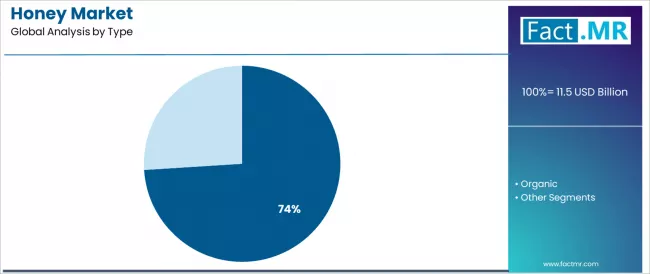
The conventional segment is projected to maintain its leading position in the honey market in 2025 with a 74.0% market share, reaffirming its role as the preferred honey type for widespread consumption and commercial applications. Honey producers and food manufacturers increasingly utilize conventional honey for its consistent availability, competitive pricing, and proven effectiveness in delivering natural sweetening benefits while maintaining product stability and supply chain reliability. Conventional honey's proven accessibility and market acceptance directly address industry requirements for scalable natural sweetening and established consumer preferences across diverse food categories and price segments.
This type segment forms the foundation of modern honey consumption, as it represents the type with the greatest contribution to volume sales and established market presence across multiple retail channels and consumer demographics. Honey industry investments in conventional production continue to strengthen adoption among producers and manufacturers. With consumer preferences requiring accessible natural sweetening solutions, conventional honey aligns with both cost objectives and quality requirements, making it the central component of comprehensive honey market strategies.
By Application, the Food & Beverage Segment Dominates Market Demand
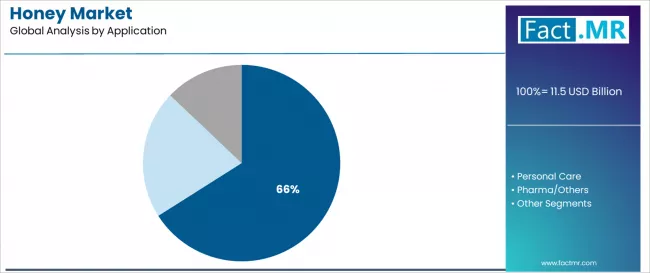
The food & beverage application segment is projected to represent the largest share of honey demand in 2025 with a 66.0% market share, underscoring its critical role as the primary driver for honey adoption across baking, confectionery, beverages, and processed food applications. Manufacturers prefer honey for food and beverage applications due to its exceptional sweetening capabilities, natural flavor enhancement, and ability to support clean label positioning while maintaining product quality and consumer appeal. Positioned as essential ingredients for natural food production, honey offers both functional advantages and marketing benefits.
The segment is supported by continuous innovation in food technology and the growing availability of specialized honey varieties that enable superior product differentiation with enhanced flavor profiles and functional benefits. Food manufacturers are investing in comprehensive natural ingredient programs to support increasingly sophisticated honey applications and consumer demand for natural and healthy food products. As clean eating trends advance and natural ingredient preferences increase, the food & beverage application will continue to dominate the market while supporting advanced product development and consumer preference optimization.
What are the Drivers, Restraints, and Key Trends of the Honey Market?
The honey market is advancing steadily due to increasing consumer preference for natural sweeteners driven by health consciousness and clean eating trends, alongside growing demand for functional food ingredients that provide health benefits, natural energy, and immune support across various dietary and wellness applications. The market faces challenges, including climate change impacts on bee populations, adulteration and quality concerns, and supply chain disruptions affecting honey production. Innovation in sustainable beekeeping practices and quality verification technologies continues to influence product authenticity and market expansion patterns.
Expansion of Health and Wellness Consumer Trends
The growing focus on health and wellness is driving demand for honey that can provide natural energy, immune system support, and antioxidant benefits through functional compounds and traditional medicinal properties that address modern health concerns. Health-conscious consumers require natural sweetening alternatives that deliver superior health benefits across multiple wellness parameters while maintaining taste appeal and nutritional value. Food and wellness companies are increasingly recognizing the competitive advantages of honey positioning for health market development and functional food innovation, creating opportunities for specialized honey products designed for specific health applications and wellness-focused consumer segments.
Integration of Sustainable Beekeeping and Traceability
Modern honey producers are incorporating sustainable beekeeping practices and advanced traceability systems to enhance environmental responsibility, support pollinator health, and ensure comprehensive quality assurance through responsible hive management, organic certification, and supply chain transparency. Leading companies are developing sustainable apiaries, implementing bee-friendly farming practices, and advancing traceability technologies that demonstrate authenticity while maintaining honey quality and environmental stewardship. These practices improve sustainability credentials while enabling new market opportunities, including certified organic honey, locally sourced products, and environmentally conscious consumer segments.
Development of Premium and Specialty Honey Varieties
The expansion of gourmet food trends and artisanal product demand is driving growth in premium honey varieties including single-origin honey, raw unprocessed honey, and specialty floral varieties that offer unique flavor profiles and enhanced nutritional characteristics. These premium honey products require specialized production capabilities and quality control systems that maintain natural characteristics while ensuring superior taste and therapeutic properties, creating premium market segments with differentiated value propositions. Producers are investing in specialty production and premium positioning to serve emerging gourmet applications while supporting innovation in artisanal food products and culinary excellence.
Analysis of the Honey Market by Key Countries

| Country | CAGR (2025-2035) |
|---|---|
| USA | 3.8% |
| Mexico | 3.4% |
| Germany | 3.2% |
| France | 3.1% |
| UK | 2.9% |
| South Korea | 2.7% |
| Japan | 2.6% |
The honey market is experiencing solid growth globally, with the USA leading at a 3.8% CAGR through 2035, driven by strong natural food market development, growing health consciousness, and increasing consumer preference for natural sweetening alternatives supporting honey adoption. Mexico follows at 3.4%, supported by traditional honey consumption culture, expanding beekeeping industries, and growing export market development. Germany shows growth at 3.2%, emphasizing organic and quality honey products, environmental consciousness, and sustainable beekeeping practices. France demonstrates 3.1% growth, supported by culinary traditions, artisanal food appreciation, and premium honey market development. The UK records 2.9%, focusing on natural food trends, health-conscious consumption, and quality honey preferences. South Korea exhibits 2.7% growth, emphasizing health benefits and premium natural products. Japan shows 2.6% growth, supported by traditional medicine applications and quality food culture.
USA Leads Global Market Growth with Natural Food Innovation
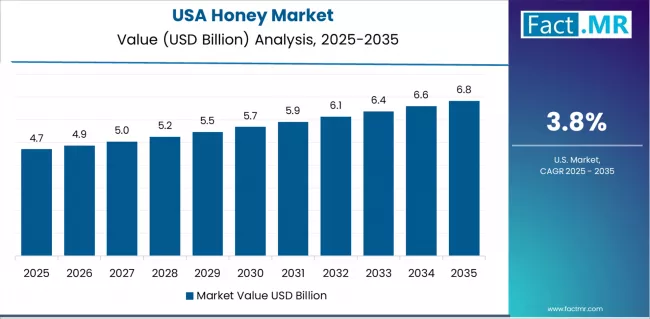
Revenue from honey in the USA is projected to exhibit strong growth with a CAGR of 3.8% through 2035, driven by extensive natural food market development and rapidly growing consumer preference for natural sweetening alternatives supporting honey adoption among health-conscious consumers, food manufacturers, and wellness-focused brands. The country's established natural products infrastructure and increasing focus on clean eating are creating substantial demand for honey solutions. Major honey producers and natural food companies are establishing comprehensive production and distribution capabilities to serve both domestic markets and natural product opportunities.
- Strong health consciousness and natural food trends are driving demand for honey throughout natural food stores, health-focused retailers, and mainstream grocery chains across urban markets, health-conscious communities, and wellness-oriented consumer segments.
- Growing clean label requirements and natural sweetener preferences are supporting the rapid adoption of honey among food manufacturers, bakeries, and beverage companies seeking natural alternatives to artificial sweeteners and refined sugar for product formulations.
Mexico Demonstrates Strong Market Potential with Traditional Culture
Demand of honey in Mexico is expanding at a CAGR of 3.4%, supported by the country's traditional honey consumption culture, extensive beekeeping heritage, and growing commercial honey production serving both domestic consumption and international export markets. The country's favorable climate conditions and beekeeping traditions are driving sophisticated honey production capabilities throughout diverse regional ecosystems. Leading honey producers and agricultural cooperatives are establishing comprehensive production and processing facilities to address growing domestic and export demand.
- Traditional consumption culture and expanding beekeeping industries are creating opportunities for honey production across rural communities, agricultural regions, and traditional beekeeping areas serving domestic and international markets.
- Growing export market development and quality improvement initiatives are driving adoption of modern beekeeping practices and quality standardization among producers seeking enhanced market access and premium positioning for Mexican honey products.
Germany Demonstrates Quality Excellence with Sustainable Focus
Revenue from honey in Germany is anticipated to grow at a CAGR of 3.2%, driven by the country's emphasis on organic and quality honey products, environmental consciousness, and comprehensive approach to sustainable beekeeping and natural food consumption supporting premium honey adoption. Germany's environmental awareness and quality standards are driving demand for sustainable honey solutions. Leading organic honey producers and specialty food companies are establishing comprehensive quality programs for environmentally responsible honey products.
- Advanced environmental consciousness and organic product preferences are creating demand for premium honey products among environmentally aware consumers seeking sustainable natural sweeteners and quality food products.
- Strong organic market development and sustainability focus are supporting the adoption of certified organic honey across organic retailers, health food stores, and environmentally conscious retail channels throughout major urban and environmental regions.
France Focuses on Culinary Excellence and Artisanal Quality
Demand of honey in France is expected to expand at a CAGR of 3.1%, driven by the country's culinary traditions, artisanal food appreciation, and sophisticated approach to premium honey varieties and gourmet food applications supporting honey integration into French culinary and food culture. France's gastronomic excellence and quality focus are supporting investment in premium honey positioning. Major artisanal producers and gourmet food companies are establishing comprehensive innovation programs incorporating honey with French culinary traditions.
- Advanced culinary culture and artisanal food appreciation are creating demand for premium honey varieties throughout specialty food retailers, gourmet markets, and culinary establishments serving quality-focused consumer segments.
- Strong gastronomic traditions and premium food culture are driving the adoption of artisanal honey products across gourmet retail channels, culinary applications, and premium food services throughout major metropolitan and culinary regions.
UK Shows Market Leadership with Health-Conscious Trends
Revenue from honey in the UK is growing at a CAGR of 2.9%, supported by the country's natural food trends, health-conscious consumption patterns, and growing preference for natural sweetening alternatives and functional food ingredients. The UK's wellness market maturity and natural product acceptance are driving demand for quality honey solutions. Leading natural food companies and health retailers are investing in honey product development and wellness positioning for health-conscious consumers.
- Advanced health consciousness and natural food trends are creating opportunities for honey products throughout health food stores, wellness retailers, and mainstream grocery chains serving health-focused consumer segments.
- Strong natural sweetener preferences and clean eating trends are driving the adoption of honey across food manufacturing, health product formulations, and wellness-oriented consumption occasions targeting natural health consumers.
South Korea Demonstrates Wellness Leadership with Premium Health Focus
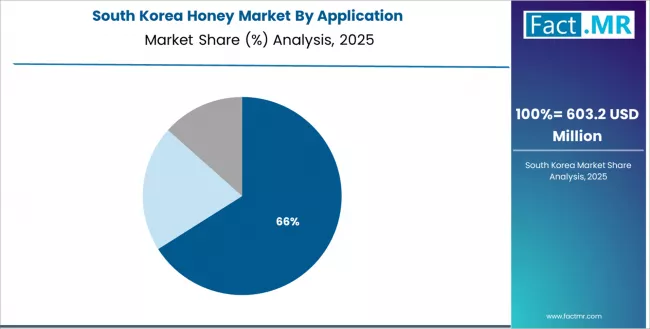
Demand for honey in South Korea is expanding at a CAGR of 2.7%, supported by the country's emphasis on health benefits, traditional medicine applications, and growing appreciation for premium natural products and functional foods supporting advanced honey adoption. The nation's health consciousness and premium product preferences are driving demand for high-quality honey solutions. Leading health companies are investing extensively in premium honey product development and health market expansion.
- Advanced health consciousness and traditional medicine integration are creating demand for honey products throughout health stores, traditional medicine centers, and premium retail outlets serving health-conscious consumer segments.
- Strong functional food trends and premium natural product focus are supporting the adoption of honey designed for health optimization, wellness lifestyle, and traditional medicine applications across diverse consumer demographics and health applications.
Japan Shows Premium Focus with Traditional Applications
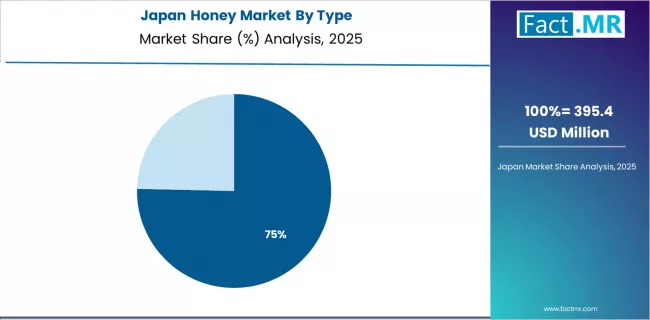
Revenue from honey in Japan is projected to grow at a CAGR of 2.6%, supported by the country's traditional medicine applications, quality food culture, and strong emphasis on authentic natural products and traditional health practices supporting honey adoption for health maintenance. Japan's quality consciousness and traditional medicine expertise are driving demand for premium honey products. Leading traditional medicine and food companies are investing in specialized capabilities for quality honey preparations and traditional health applications.
- Advanced traditional medicine culture and quality food standards are creating opportunities for honey products throughout traditional medicine practitioners, specialty food stores, and quality-focused retail channels serving traditional medicine consumers and health-conscious segments.
- Strong quality consciousness and traditional health focus are driving adoption of premium honey products meeting Japanese consumer expectations for authenticity, natural purity, and comprehensive health support across diverse traditional medicine and wellness applications.
Europe Market Split by Country
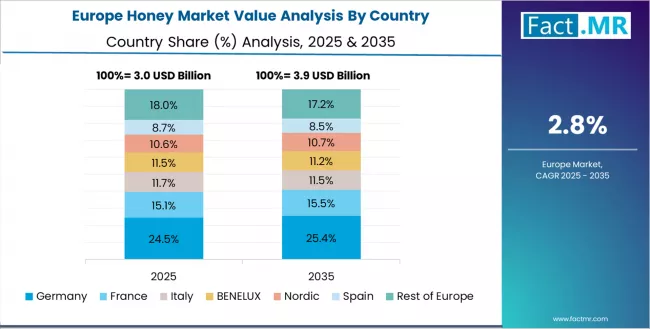
The honey market in Europe is projected to grow from USD 3.2 billion in 2025 to USD 4.4 billion by 2035, registering a CAGR of 3.1% over the forecast period. Germany is expected to maintain leadership with a 26.6% market share in 2025, moderating to 26.4% by 2035, supported by organic product emphasis, environmental consciousness, and sustainable beekeeping practices.
France follows with 21.9% in 2025, projected to reach 22.1% by 2035, driven by culinary traditions, artisanal food appreciation, and premium honey market development. The United Kingdom holds 18.8% in 2025, expected to reach 18.9% by 2035 due to natural food trends and health-conscious consumption. Italy commands 16.2% in 2025, rising to 16.3% by 2035, while Spain accounts for 10.9% in 2025, reaching 11.0% by 2035. The Rest of Europe region is anticipated to hold 5.6% in 2025 and 5.3% by 2035, reflecting steady honey market development in Nordic countries and emerging beekeeping markets in Eastern European countries with traditional honey production heritage.
Competitive Landscape of the Honey Market
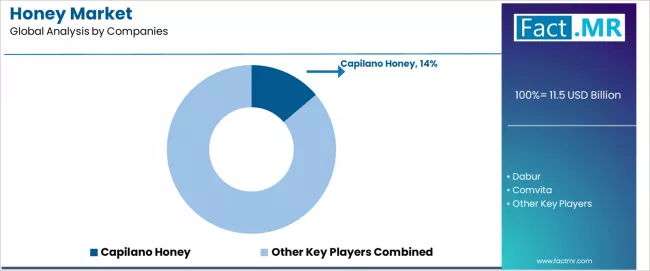
The honey market is characterized by competition among established honey producers, agricultural cooperatives, and specialty food companies. Companies are investing in sustainable beekeeping technology development, quality assurance systems, supply chain traceability, and product innovation to deliver authentic, high-quality, and responsibly sourced honey solutions. Innovation in beekeeping practices, processing methods, and premium product development is central to strengthening market position and competitive advantage.
Capilano Honey leads the market with a 13.8% share, offering comprehensive honey solutions with focus on quality assurance, sustainable beekeeping practices, and extensive product portfolio across diverse consumer segments and commercial applications. The company continues investing in beekeeping partnerships, processing capabilities, and quality control systems while expanding international distribution and brand development programs. Dabur provides extensive natural product solutions with emphasis on traditional medicine and health applications. Comvita specializes in premium Manuka honey and bee-derived health products. Bee Maid focuses on cooperative beekeeping and quality honey production. Rowse emphasizes British honey heritage and quality standards. Sioux Honey represents cooperative honey marketing and distribution.
Key Players in the Honey Market
- Capilano Honey
- Dabur
- Comvita
- Bee Maid
- Rowse
- Sioux Honey
- Dutch Gold
- Billy Bee
- Barkman Honey
- Patanjali Ayurved
Scope of the Report
| Items | Values |
|---|---|
| Quantitative Units (2025) | USD 11.5 billion |
| Type | Conventional, Organic |
| Application | Food & Beverage, Personal Care, Pharma/Others |
| Form | Liquid, Creamed/Crystallized |
| Regions Covered | North America, Europe, Asia-Pacific, Latin America, Middle East & Africa |
| Countries Covered | USA, Mexico, Germany, France, UK, Japan, South Korea, and 40+ countries |
| Key Companies Profiled | Capilano Honey, Dabur, Comvita, Bee Maid, Rowse, Sioux Honey |
| Additional Attributes | Dollar sales by type and application, regional demand trends, competitive landscape, sustainable beekeeping development, quality assurance advancement, traceability systems, and health benefit optimization |
Honey Market by Segments
-
Type :
- Conventional
- Organic
-
Application :
- Food & Beverage
- Personal Care
- Pharma/Others
-
Form :
- Liquid
- Creamed/Crystallized
-
Region :
-
North America
- United States
- Canada
- Mexico
-
Europe
- Germany
- United Kingdom
- France
- Italy
- Spain
- Netherlands
- Rest of Europe
-
Asia-Pacific
- Japan
- South Korea
- China
- India
- Australia
- Rest of Asia-Pacific
-
Latin America
- Brazil
- Argentina
- Rest of Latin America
-
Middle East & Africa
- Kingdom of Saudi Arabia
- South Africa
- Rest of Middle East & Africa
-
Table of Content
- Executive Summary
- Global Market Outlook
- Demand to side Trends
- Supply to side Trends
- Technology Roadmap Analysis
- Analysis and Recommendations
- Market Overview
- Market Coverage / Taxonomy
- Market Definition / Scope / Limitations
- Market Background
- Market Dynamics
- Drivers
- Restraints
- Opportunity
- Trends
- Scenario Forecast
- Demand in Optimistic Scenario
- Demand in Likely Scenario
- Demand in Conservative Scenario
- Opportunity Map Analysis
- Product Life Cycle Analysis
- Supply Chain Analysis
- Investment Feasibility Matrix
- Value Chain Analysis
- PESTLE and Porter’s Analysis
- Regulatory Landscape
- Regional Parent Market Outlook
- Production and Consumption Statistics
- Import and Export Statistics
- Market Dynamics
- Global Market Analysis 2020 to 2024 and Forecast, 2025 to 2035
- Historical Market Size Value (USD Million) Analysis, 2020 to 2024
- Current and Future Market Size Value (USD Million) Projections, 2025 to 2035
- Y to o to Y Growth Trend Analysis
- Absolute $ Opportunity Analysis
- Global Market Pricing Analysis 2020 to 2024 and Forecast 2025 to 2035
- Global Market Analysis 2020 to 2024 and Forecast 2025 to 2035, By Type
- Introduction / Key Findings
- Historical Market Size Value (USD Million) Analysis By Type , 2020 to 2024
- Current and Future Market Size Value (USD Million) Analysis and Forecast By Type , 2025 to 2035
- Conventional
- Organic
- Y to o to Y Growth Trend Analysis By Type , 2020 to 2024
- Absolute $ Opportunity Analysis By Type , 2025 to 2035
- Global Market Analysis 2020 to 2024 and Forecast 2025 to 2035, By Application
- Introduction / Key Findings
- Historical Market Size Value (USD Million) Analysis By Application, 2020 to 2024
- Current and Future Market Size Value (USD Million) Analysis and Forecast By Application, 2025 to 2035
- Food & Beverage
- Personal Care
- Pharma/Others
- Y to o to Y Growth Trend Analysis By Application, 2020 to 2024
- Absolute $ Opportunity Analysis By Application, 2025 to 2035
- Global Market Analysis 2020 to 2024 and Forecast 2025 to 2035, By Region
- Introduction
- Historical Market Size Value (USD Million) Analysis By Region, 2020 to 2024
- Current Market Size Value (USD Million) Analysis and Forecast By Region, 2025 to 2035
- North America
- Latin America
- Western Europe
- Eastern Europe
- East Asia
- South Asia and Pacific
- Middle East & Africa
- Market Attractiveness Analysis By Region
- North America Market Analysis 2020 to 2024 and Forecast 2025 to 2035, By Country
- Historical Market Size Value (USD Million) Trend Analysis By Market Taxonomy, 2020 to 2024
- Market Size Value (USD Million) Forecast By Market Taxonomy, 2025 to 2035
- By Country
- USA
- Canada
- Mexico
- By Type
- By Application
- By Country
- Market Attractiveness Analysis
- By Country
- By Type
- By Application
- Key Takeaways
- Latin America Market Analysis 2020 to 2024 and Forecast 2025 to 2035, By Country
- Historical Market Size Value (USD Million) Trend Analysis By Market Taxonomy, 2020 to 2024
- Market Size Value (USD Million) Forecast By Market Taxonomy, 2025 to 2035
- By Country
- Brazil
- Chile
- Rest of Latin America
- By Type
- By Application
- By Country
- Market Attractiveness Analysis
- By Country
- By Type
- By Application
- Key Takeaways
- Western Europe Market Analysis 2020 to 2024 and Forecast 2025 to 2035, By Country
- Historical Market Size Value (USD Million) Trend Analysis By Market Taxonomy, 2020 to 2024
- Market Size Value (USD Million) Forecast By Market Taxonomy, 2025 to 2035
- By Country
- Germany
- UK
- Italy
- Spain
- France
- Nordic
- BENELUX
- Rest of Western Europe
- By Type
- By Application
- By Country
- Market Attractiveness Analysis
- By Country
- By Type
- By Application
- Key Takeaways
- Eastern Europe Market Analysis 2020 to 2024 and Forecast 2025 to 2035, By Country
- Historical Market Size Value (USD Million) Trend Analysis By Market Taxonomy, 2020 to 2024
- Market Size Value (USD Million) Forecast By Market Taxonomy, 2025 to 2035
- By Country
- Russia
- Poland
- Hungary
- Balkan & Baltic
- Rest of Eastern Europe
- By Type
- By Application
- By Country
- Market Attractiveness Analysis
- By Country
- By Type
- By Application
- Key Takeaways
- East Asia Market Analysis 2020 to 2024 and Forecast 2025 to 2035, By Country
- Historical Market Size Value (USD Million) Trend Analysis By Market Taxonomy, 2020 to 2024
- Market Size Value (USD Million) Forecast By Market Taxonomy, 2025 to 2035
- By Country
- China
- Japan
- South Korea
- By Type
- By Application
- By Country
- Market Attractiveness Analysis
- By Country
- By Type
- By Application
- Key Takeaways
- South Asia and Pacific Market Analysis 2020 to 2024 and Forecast 2025 to 2035, By Country
- Historical Market Size Value (USD Million) Trend Analysis By Market Taxonomy, 2020 to 2024
- Market Size Value (USD Million) Forecast By Market Taxonomy, 2025 to 2035
- By Country
- India
- ASEAN
- Australia & New Zealand
- Rest of South Asia and Pacific
- By Type
- By Application
- By Country
- Market Attractiveness Analysis
- By Country
- By Type
- By Application
- Key Takeaways
- Middle East & Africa Market Analysis 2020 to 2024 and Forecast 2025 to 2035, By Country
- Historical Market Size Value (USD Million) Trend Analysis By Market Taxonomy, 2020 to 2024
- Market Size Value (USD Million) Forecast By Market Taxonomy, 2025 to 2035
- By Country
- Kingdom of Saudi Arabia
- Other GCC Countries
- Turkiye
- South Africa
- Other African Union
- Rest of Middle East & Africa
- By Type
- By Application
- By Country
- Market Attractiveness Analysis
- By Country
- By Type
- By Application
- Key Takeaways
- Key Countries Market Analysis
- USA
- Pricing Analysis
- Market Share Analysis, 2024
- By Type
- By Application
- Canada
- Pricing Analysis
- Market Share Analysis, 2024
- By Type
- By Application
- Mexico
- Pricing Analysis
- Market Share Analysis, 2024
- By Type
- By Application
- Brazil
- Pricing Analysis
- Market Share Analysis, 2024
- By Type
- By Application
- Chile
- Pricing Analysis
- Market Share Analysis, 2024
- By Type
- By Application
- Germany
- Pricing Analysis
- Market Share Analysis, 2024
- By Type
- By Application
- UK
- Pricing Analysis
- Market Share Analysis, 2024
- By Type
- By Application
- Italy
- Pricing Analysis
- Market Share Analysis, 2024
- By Type
- By Application
- Spain
- Pricing Analysis
- Market Share Analysis, 2024
- By Type
- By Application
- France
- Pricing Analysis
- Market Share Analysis, 2024
- By Type
- By Application
- India
- Pricing Analysis
- Market Share Analysis, 2024
- By Type
- By Application
- ASEAN
- Pricing Analysis
- Market Share Analysis, 2024
- By Type
- By Application
- Australia & New Zealand
- Pricing Analysis
- Market Share Analysis, 2024
- By Type
- By Application
- China
- Pricing Analysis
- Market Share Analysis, 2024
- By Type
- By Application
- Japan
- Pricing Analysis
- Market Share Analysis, 2024
- By Type
- By Application
- South Korea
- Pricing Analysis
- Market Share Analysis, 2024
- By Type
- By Application
- Russia
- Pricing Analysis
- Market Share Analysis, 2024
- By Type
- By Application
- Poland
- Pricing Analysis
- Market Share Analysis, 2024
- By Type
- By Application
- Hungary
- Pricing Analysis
- Market Share Analysis, 2024
- By Type
- By Application
- Kingdom of Saudi Arabia
- Pricing Analysis
- Market Share Analysis, 2024
- By Type
- By Application
- Turkiye
- Pricing Analysis
- Market Share Analysis, 2024
- By Type
- By Application
- South Africa
- Pricing Analysis
- Market Share Analysis, 2024
- By Type
- By Application
- USA
- Market Structure Analysis
- Competition Dashboard
- Competition Benchmarking
- Market Share Analysis of Top Players
- By Regional
- By Type
- By Application
- Competition Analysis
- Competition Deep Dive
- Capilano Honey
- Overview
- Product Portfolio
- Profitability by Market Segments (Product/Age /Sales Channel/Region)
- Sales Footprint
- Strategy Overview
- Marketing Strategy
- Product Strategy
- Channel Strategy
- Dabur
- Comvita
- Bee Maid
- Rowse
- Sioux Honey
- Dutch Gold
- Billy Bee
- Barkman Honey
- Patanjali Ayurved
- Capilano Honey
- Competition Deep Dive
- Assumptions & Acronyms Used
- Research Methodology
List Of Table
- Table 1: Global Market Value (USD Million) Forecast by Region, 2020 to 2035
- Table 2: Global Market Value (USD Million) Forecast by Type , 2020 to 2035
- Table 3: Global Market Value (USD Million) Forecast by Application, 2020 to 2035
- Table 4: North America Market Value (USD Million) Forecast by Country, 2020 to 2035
- Table 5: North America Market Value (USD Million) Forecast by Type , 2020 to 2035
- Table 6: North America Market Value (USD Million) Forecast by Application, 2020 to 2035
- Table 7: Latin America Market Value (USD Million) Forecast by Country, 2020 to 2035
- Table 8: Latin America Market Value (USD Million) Forecast by Type , 2020 to 2035
- Table 9: Latin America Market Value (USD Million) Forecast by Application, 2020 to 2035
- Table 10: Western Europe Market Value (USD Million) Forecast by Country, 2020 to 2035
- Table 11: Western Europe Market Value (USD Million) Forecast by Type , 2020 to 2035
- Table 12: Western Europe Market Value (USD Million) Forecast by Application, 2020 to 2035
- Table 13: Eastern Europe Market Value (USD Million) Forecast by Country, 2020 to 2035
- Table 14: Eastern Europe Market Value (USD Million) Forecast by Type , 2020 to 2035
- Table 15: Eastern Europe Market Value (USD Million) Forecast by Application, 2020 to 2035
- Table 16: East Asia Market Value (USD Million) Forecast by Country, 2020 to 2035
- Table 17: East Asia Market Value (USD Million) Forecast by Type , 2020 to 2035
- Table 18: East Asia Market Value (USD Million) Forecast by Application, 2020 to 2035
- Table 19: South Asia and Pacific Market Value (USD Million) Forecast by Country, 2020 to 2035
- Table 20: South Asia and Pacific Market Value (USD Million) Forecast by Type , 2020 to 2035
- Table 21: South Asia and Pacific Market Value (USD Million) Forecast by Application, 2020 to 2035
- Table 22: Middle East & Africa Market Value (USD Million) Forecast by Country, 2020 to 2035
- Table 23: Middle East & Africa Market Value (USD Million) Forecast by Type , 2020 to 2035
- Table 24: Middle East & Africa Market Value (USD Million) Forecast by Application, 2020 to 2035
List Of Figures
- Figure 1: Global Market Pricing Analysis
- Figure 2: Global Market Value (USD Million) Forecast 2020-2035
- Figure 3: Global Market Value Share and BPS Analysis by Type , 2025 and 2035
- Figure 4: Global Market Y to o to Y Growth Comparison by Type , 2025-2035
- Figure 5: Global Market Attractiveness Analysis by Type
- Figure 6: Global Market Value Share and BPS Analysis by Application, 2025 and 2035
- Figure 7: Global Market Y to o to Y Growth Comparison by Application, 2025-2035
- Figure 8: Global Market Attractiveness Analysis by Application
- Figure 9: Global Market Value (USD Million) Share and BPS Analysis by Region, 2025 and 2035
- Figure 10: Global Market Y to o to Y Growth Comparison by Region, 2025-2035
- Figure 11: Global Market Attractiveness Analysis by Region
- Figure 12: North America Market Incremental Dollar Opportunity, 2025-2035
- Figure 13: Latin America Market Incremental Dollar Opportunity, 2025-2035
- Figure 14: Western Europe Market Incremental Dollar Opportunity, 2025-2035
- Figure 15: Eastern Europe Market Incremental Dollar Opportunity, 2025-2035
- Figure 16: East Asia Market Incremental Dollar Opportunity, 2025-2035
- Figure 17: South Asia and Pacific Market Incremental Dollar Opportunity, 2025-2035
- Figure 18: Middle East & Africa Market Incremental Dollar Opportunity, 2025-2035
- Figure 19: North America Market Value Share and BPS Analysis by Country, 2025 and 2035
- Figure 20: North America Market Value Share and BPS Analysis by Type , 2025 and 2035
- Figure 21: North America Market Y to o to Y Growth Comparison by Type , 2025-2035
- Figure 22: North America Market Attractiveness Analysis by Type
- Figure 23: North America Market Value Share and BPS Analysis by Application, 2025 and 2035
- Figure 24: North America Market Y to o to Y Growth Comparison by Application, 2025-2035
- Figure 25: North America Market Attractiveness Analysis by Application
- Figure 26: Latin America Market Value Share and BPS Analysis by Country, 2025 and 2035
- Figure 27: Latin America Market Value Share and BPS Analysis by Type , 2025 and 2035
- Figure 28: Latin America Market Y to o to Y Growth Comparison by Type , 2025-2035
- Figure 29: Latin America Market Attractiveness Analysis by Type
- Figure 30: Latin America Market Value Share and BPS Analysis by Application, 2025 and 2035
- Figure 31: Latin America Market Y to o to Y Growth Comparison by Application, 2025-2035
- Figure 32: Latin America Market Attractiveness Analysis by Application
- Figure 33: Western Europe Market Value Share and BPS Analysis by Country, 2025 and 2035
- Figure 34: Western Europe Market Value Share and BPS Analysis by Type , 2025 and 2035
- Figure 35: Western Europe Market Y to o to Y Growth Comparison by Type , 2025-2035
- Figure 36: Western Europe Market Attractiveness Analysis by Type
- Figure 37: Western Europe Market Value Share and BPS Analysis by Application, 2025 and 2035
- Figure 38: Western Europe Market Y to o to Y Growth Comparison by Application, 2025-2035
- Figure 39: Western Europe Market Attractiveness Analysis by Application
- Figure 40: Eastern Europe Market Value Share and BPS Analysis by Country, 2025 and 2035
- Figure 41: Eastern Europe Market Value Share and BPS Analysis by Type , 2025 and 2035
- Figure 42: Eastern Europe Market Y to o to Y Growth Comparison by Type , 2025-2035
- Figure 43: Eastern Europe Market Attractiveness Analysis by Type
- Figure 44: Eastern Europe Market Value Share and BPS Analysis by Application, 2025 and 2035
- Figure 45: Eastern Europe Market Y to o to Y Growth Comparison by Application, 2025-2035
- Figure 46: Eastern Europe Market Attractiveness Analysis by Application
- Figure 47: East Asia Market Value Share and BPS Analysis by Country, 2025 and 2035
- Figure 48: East Asia Market Value Share and BPS Analysis by Type , 2025 and 2035
- Figure 49: East Asia Market Y to o to Y Growth Comparison by Type , 2025-2035
- Figure 50: East Asia Market Attractiveness Analysis by Type
- Figure 51: East Asia Market Value Share and BPS Analysis by Application, 2025 and 2035
- Figure 52: East Asia Market Y to o to Y Growth Comparison by Application, 2025-2035
- Figure 53: East Asia Market Attractiveness Analysis by Application
- Figure 54: South Asia and Pacific Market Value Share and BPS Analysis by Country, 2025 and 2035
- Figure 55: South Asia and Pacific Market Value Share and BPS Analysis by Type , 2025 and 2035
- Figure 56: South Asia and Pacific Market Y to o to Y Growth Comparison by Type , 2025-2035
- Figure 57: South Asia and Pacific Market Attractiveness Analysis by Type
- Figure 58: South Asia and Pacific Market Value Share and BPS Analysis by Application, 2025 and 2035
- Figure 59: South Asia and Pacific Market Y to o to Y Growth Comparison by Application, 2025-2035
- Figure 60: South Asia and Pacific Market Attractiveness Analysis by Application
- Figure 61: Middle East & Africa Market Value Share and BPS Analysis by Country, 2025 and 2035
- Figure 62: Middle East & Africa Market Value Share and BPS Analysis by Type , 2025 and 2035
- Figure 63: Middle East & Africa Market Y to o to Y Growth Comparison by Type , 2025-2035
- Figure 64: Middle East & Africa Market Attractiveness Analysis by Type
- Figure 65: Middle East & Africa Market Value Share and BPS Analysis by Application, 2025 and 2035
- Figure 66: Middle East & Africa Market Y to o to Y Growth Comparison by Application, 2025-2035
- Figure 67: Middle East & Africa Market Attractiveness Analysis by Application
- Figure 68: Global Market - Tier Structure Analysis
- Figure 69: Global Market - Company Share Analysis
- FAQs -
How big is the honey market in 2025?
The global honey market is estimated to be valued at USD 11.5 billion in 2025.
What will be the size of honey market in 2035?
The market size for the honey market is projected to reach USD 15.9 billion by 2035.
How much will be the honey market growth between 2025 and 2035?
The honey market is expected to grow at a 3.3% CAGR between 2025 and 2035.
What are the key product types in the honey market?
The key product types in honey market are conventional and organic.
Which application segment to contribute significant share in the honey market in 2025?
In terms of application, food & beverage segment to command 66.0% share in the honey market in 2025.